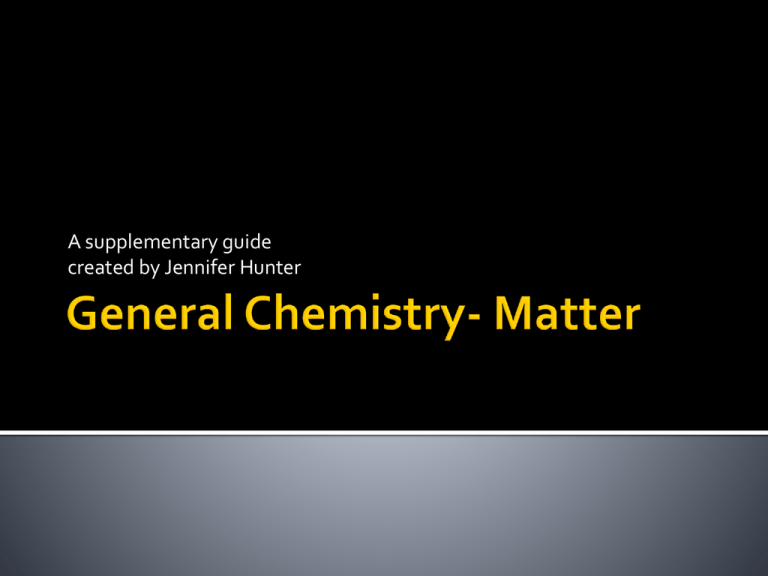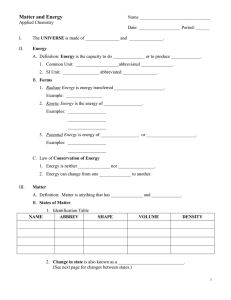A supplementary guide created by Jennifer Hunter
advertisement

A supplementary guide created by Jennifer Hunter Chemistry summed up in one definition is the study of matter specifically the movement of electrons. Matter is anything that has mass in the universe, that is anything that takes up space. ▪ E.g. The clothes or jewelry you are wearing, or the apple you had for lunch. ▪ Atoms are the building blocks of matter. They are incredibly small and their structure is unique to different elements. Since matter is anything that has mass it is important to be able to measure mass. The Standard unit for measuring mass is the Kilogram Matter is typically divided into 3 different states. Solids: Have a definite size and shape ▪ Atoms or molecules are close together ▪ Minimal Movement/vibration Liquids: Have a definite volume, but take the shape of their container. Gases: Take both the shape and volume of their container ▪ Atoms/molecules are farthest apart with ▪ Lots of movement There are two major classifications Pure Substances and Mixtures Pure Substances Elements: made up of only one kind of atom Compounds: made up of two or more kinds of atoms. ▪ Can only be separated by chemical means. ▪ Note: A molecule is a piece of a compound. Mixtures: combinations of two or more substances that retains its own chemical identity and its own properties. Heterogeneous mixtures: a combination of two or more individual materials which keep their original properties when mixed together ▪ E.g. Trail Mix Homogeneous Mixtures: Mixtures that have the same appearance throughout. There are many examples of Homogeneous mixtures including salt water and air. ▪ Note: Homogenous mixtures are also called solutions. Based on the size of its largest particles a mixture can be classified as a solution, a suspension, or a colloid. Solutions When substances dissolve and form a homogeneous mixture. Cannot see particles E.g. Windshield wiper fluid, tap water, sugar water Suspensions A heterogeneous mixture that separate into layers over time. E.g. Dust in the air or Italian salad dressing Colloids Mixture of particle size, but do not separate into layers. E.g. Fog There are both physical and chemical properties of matter Physical Properties: Intensive- depend on the nature of the material ▪ Malleability- capability of being flattened or shaped into thin sheets by pounding with a hammer. ▪ Ductility- capability of being drawn out into a thin wire ▪ Conductivity- the ability to transfer heat or electricity ▪ E.g. color, smell, luster, texture, crystalline Physical Properties Extensive- depend on the amount of material ▪ Mass ▪ Volume Physical Changes: changes only the appearance. The substance keeps its other properties Dissolving Centrifuging Distillation Boiling Point Evaporation Filtration Chromatography Melting point Chemical Properties: the ability of a substance to react with another substance or decompose. E.g. corrosiveness, flammability, acidity, toxicity Chemical Changes: occur when atoms rearrange to transform the original substance into a different substance. E.g. A bike rusting Physical and Chemical changes in matter are always accompanied by changes in energy. Changes in Kinetic, Potential, and Thermal energy for an object will help to decide if the reaction is either ▪ Exothermic- energy is released into the surrounding through heat, light, or sound ▪ Endothermic- energy is absorbed by the object; temperature decreases. Law of Conservation of Mass: Matter is neither created nor destroyed; it only changes form. The total amount of matter in the universe remains constant. Law of Conservation of Energy: Energy is neither created nor destroyed; it only changes form. The total amount of energy in the universe remains constant. Law of Conservation of Mass-Energy The sum of mass and energy is conserved Mass and energy can be changed from one to the other The total cannot be increased or decreased http://hubpages.com/hub/Heterogeneous-and-HomogeneousMixtures http://61.19.145.8/student/m5year200621508/group14/rooms.html http://answers.com/topic/solution http://mediabistro.com/fishbowlny/newspapers/future_of_newsp apers_looking_on_the_bright_side_93850.asp http://wps.prenhall.com/wps/media/objects/165/169061/blb9ch01 02.html http://mrsdlovesscience.com/measure.html http://hackedgadges.com/2006/09/01/alcohol-stove http://thriftyfun.com/tf34205129.tip.html http://suwaneedental.com/travel/travel-vancouver-2004.htm



